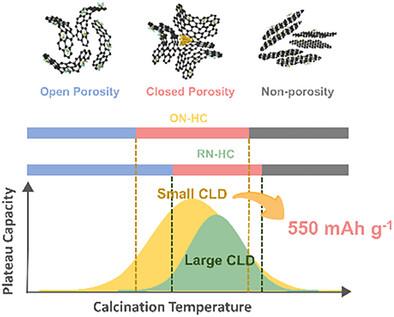锂离子电池的Novolak衍生硬碳负极:通过前驱体交联密度的闭孔工程
IF 19
1区 材料科学
Q1 CHEMISTRY, MULTIDISCIPLINARY
引用次数: 0
摘要
硬碳(HC)在钠离子电池(sib)中取得了巨大的成功,在低电位状态下具有平台容量,延长了全电池的工作电压,类似于锂离子电池(lib)中的石墨。然而,这种独特的电化学特征在HC在lib中的应用中很少观察到,这是由于HC微观结构和Li +在低电位状态下存储机制的内在差异。本文采用一种具有可控交联密度(CLD)的novolak树脂前驱体来制备hc。通过改变催化剂,低聚物之间的结合位置从随机分布转移到大多数邻位。当代材料分析表明,低CLD前驱体在早期往往形成伪石墨层,在适宜的碳化条件下形成丰富的封闭孔隙。锂离子平台容量与封闭孔隙体积之间的良好相关性以及原位XRD和拉曼分析证实了低电位平台是由Li+填充到这些novolak衍生的hc的封闭孔隙中造成的。因此,在最佳合成条件下,HC的可逆容量达到550 mAh g - 1,其中包括约50%的平台容量(255 mAh g - 1)。这项工作为闭合孔工程和低电位平台的起源提供了全面的理解,为高性能lib的微结构工程提供了一条有希望的途径。本文章由计算机程序翻译,如有差异,请以英文原文为准。

Novolak‐Derived Hard Carbon Negative Electrodes for Lithium‐Ion Batteries: Closed Pore Engineering via Cross‐linking Density of Precursors
Hard carbon (HC) has achieved huge success in sodium‐ion batteries (SIBs) with a plateau capacity in the low‐potential regime extending the working voltage of full cells, similar to graphite in lithium‐ion batteries (LIBs). However, this unique electrochemical signature is rarely observed in the application of HC in LIBs, due to the inherent differences in the HC microstructure and Li⁺ storage mechanism at the low‐potential regime. Herein, a novolak resin precursor with controllable cross–linking density (CLD) is used to fabricate HCs. By varying the catalysts, the binding position among oligomers shifts from random distributions to mostly ortho sites. Contemporary material analyses reveal that low‐CLD precursors tend to form pseudo‐graphitic layers at early stage, generating abundant closed pores under suitable carbonization condition. A well correlation between Li─ion plateau capacity and closed pore volume along with in situ XRD and Raman analyses confirms that low‐potential plateau results from Li+ filling into closed pores in these novolak‐derived HCs. Consequently, the HC with optimal synthesis conditions achieves a reversible capacity of 550 mAh g⁻1 , including ≈ 50% plateau capacity (255 mAh g⁻1 ). This work provides comprehensive understanding in closed pore engineering and the origin of low‐potential plateau, offering a promising route for microstructural engineering toward high‐performance LIBs.
求助全文
通过发布文献求助,成功后即可免费获取论文全文。
去求助
来源期刊

Advanced Functional Materials
工程技术-材料科学:综合
CiteScore
29.50
自引率
4.20%
发文量
2086
审稿时长
2.1 months
期刊介绍:
Firmly established as a top-tier materials science journal, Advanced Functional Materials reports breakthrough research in all aspects of materials science, including nanotechnology, chemistry, physics, and biology every week.
Advanced Functional Materials is known for its rapid and fair peer review, quality content, and high impact, making it the first choice of the international materials science community.
 求助内容:
求助内容: 应助结果提醒方式:
应助结果提醒方式:


